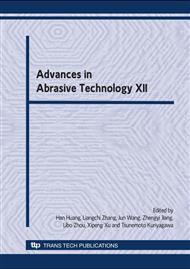p.94
p.101
p.107
p.113
p.119
p.125
p.131
p.137
p.143
The Effect of Special Structured Electroplated CBN Wheel in Dry Grinding of 100Cr6
Abstract:
In many grinding applications, the material removal rate (MRR) is constrained by undesired thermal surface damages like burns and tensile residual stresses as well as dimensional inaccuracy. In dry grinding, due to lack of coolant, the limitation to achieve higher MRR is more critical as the major part of the heat, generated on the contact zone, is transferred to the workpiece. That is why the lower heat generation is a most important target by dry grinding. This paper presents some of the very interesting results by a comparison between a structured electroplated CBN wheel and a conventional one during surface grinding of steel. One of the grinding wheels has the normal structure and the other has special macro-structure topography developed for dry grinding. The results show a considerable reduction in grinding forces and less thermal damages using the novel electroplated CBN wheel comparing to conventional wheel.
Info:
Periodical:
Pages:
119-124
Citation:
Online since:
June 2009
Authors:
Keywords:
Price:
Сopyright:
© 2009 Trans Tech Publications Ltd. All Rights Reserved
Share:
Citation:


